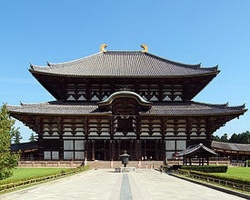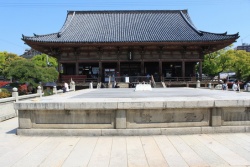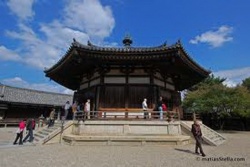Difference between revisions of "Main Hall (Japanese Buddhism)"
| (12 intermediate revisions by 3 users not shown) | |||
| Line 1: | Line 1: | ||
[[File:Tōdai-ji_Kon-dō.jpg|thumb|250px|]] | [[File:Tōdai-ji_Kon-dō.jpg|thumb|250px|]] | ||
| − | |||
| − | |||
| − | |||
| − | |||
| − | |||
| − | |||
| − | ==Hon-dō (Heian period) == | + | |
| + | |||
| + | |||
| + | [[Main hall]] is the term used in {{Wiki|English}} for the building within a [[Japanese]] [[Buddhist]] [[temple]] compound ([[garan]]) which enshrines the main [[object]] of [[veneration]]. Because the various denominations deliberately use different terms, this single {{Wiki|English}} term translates several [[Japanese]] words, among them [[Butsuden]], [[Butsu-dō]], [[kon-dō]], [[konpon-chūdō]], and [[hon-dō]]. [[Hon-dō]] is its exact [[Japanese]] {{Wiki|equivalent}}, while the others are more specialized words used by particular sects or for edifices having a particular {{Wiki|structure}}. | ||
| + | |||
| + | == [[Kon-dō]] ({{Wiki|Asuka}} and [[Nara]] periods) == | ||
| + | |||
| + | The term [[kon-dō]] ([[金堂]]), literally "golden hall", started to be used during the {{Wiki|Asuka}} and [[Nara]] periods. A [[kon-dō]] is the centerpiece of an {{Wiki|ancient}} [[Buddhist]] temple's [[garan]] in [[Japan]]. The origin of the [[Name]] is uncertain, but it may derive from the [[perceived]] preciousness of its content, or from the fact that the interior was lined with {{Wiki|gold}}. This is the [[Name]] used by the oldest [[temples]] in The country . | ||
| + | |||
| + | A [[kon-dō]], for example [[Hōryū-ji's]] is a true two-story building with a 3x2 bay {{Wiki|central}} core ([[moya]]) surrounded by a 1-bay wide aisles ([[hisashi]] ([[廂]]) making it 5x4 bays, surrounded by an {{Wiki|external}} 1-bay wide [[mokoshi]], for a total of 9x7 bays . The second story has the same {{Wiki|dimensions}} as the temple's core at the first story, (3x2 bays), but has no [[mokoshi]]. | ||
| + | |||
| + | Some [[temples]], for example [[Asuka-dera]] or [[Hōryū-ji]], have more than one [[kon-dō]], but normally only one [[exists]] and is the first building to be built . Because of its limited size, worshipers were not allowed to enter the building and had to stand outside. The [[kon-dō]] and a [[Pagoda]] were usually surrounded by a corridor called [[kairō]]. | ||
| + | |||
| + | The use of [[kon-dō]] declined after the 10th century, when it was replaced by a [[hon-dō]] divided in [[naijin]] ([[内陣]]) (inner [[Sanctuary]] reserved to the [[Deity]]) and [[gejin]] ([[外陣]]) ([[space]] for worshipers, like the nave in a {{Wiki|church}}). The term remained in some use even up to the {{Wiki|Edo period}}, but its frequency decreased drastically after the [[appearance]] of the term [[hon-dō]] in the {{Wiki|Heian period}}. | ||
| + | |||
| + | ==[[Hon-dō]] ({{Wiki|Heian period}}) == | ||
[[File:562.jpg|thumb|250px|]] | [[File:562.jpg|thumb|250px|]] | ||
| − | The term hon-dō (本堂?), literally means "main hall" | + | The term [[hon-dō]] ([[本堂]]?), literally means "[[main hall]]" and it enshrines the most important [[objects]] of [[veneration]] . The term is [[Thought]] to have evolved during the 9th century to avoid the early term [[kondō]], at the [[Time]] used by six [[Nara]] sects called the [[Nanto Rokushū]] ([[南都六宗]] [[Nara six sects]]) . It became common after the introduction of the two [[Mikkyo]] sects ([[Tendai]] and [[Shingon]]) to [[Japan]]. |
| − | Various new types of temple buildings, including the hon-dō, were built during the Heian period, in response to the requirements of new doctrines. Different buildings were called hon-dō depending on the sect, for example: the kondō (Shingon), the chudō (Tendai), mieidō (Jōdo), the Amida-dō (Shinshu). A notable | + | Various new types of [[temple]] buildings, [[including]] the [[hon-dō]], were built during the {{Wiki|Heian period}}, in response to the requirements of new [[doctrines]]. Different buildings were called [[hon-dō]] depending on the [[sect]], for example: the [[kondō]] ([[Shingon]]), the [[chudō]] ([[Tendai]]), [[mieidō]] ([[Jōdo]]), the [[Amida-dō]] ([[Shinshu]]). A notable [[Evolution]] of the [[hon-dō]] during this period is the inclusion of a [[space]] for worshipers inside the [[hon-dō]] itself, called [[gejin]] (see above). |
| − | Other names such as Konpon-chūdō (根本中堂 | + | Other names such as [[Konpon-chūdō]] ([[根本中堂]]), literally "cardinal {{Wiki|central}} hall" are used as well, for example for the [[main hall]] at [[Wikipedia:Mount Hiei|Mount Hiei's]] [[Enryaku-ji]]. The {{Wiki|Tokugawa}} [[funeral]] [[temple]] of [[Kan'ei-ji]], which had been built explicitly to imitate [[Enryaku-ji]], also had one, though it has not survived. [[Yama-dera]] in [[Yamagata]] is another example of a [[temple]] using this [[Name]]. |
| − | == Butsuden (Kamakura period) == | + | == [[Butsuden]] ([[Kamakura period]]) == |
| − | This single storied Zen butsuden at Myōshin-ji seems to have two stories because of its mokoshi. | + | This single storied [[Zen]] [[butsuden]] at [[Myōshin-ji]] seems to have two stories because of its [[mokoshi]]. |
| − | The Butsuden or Butsu-dō (仏殿・仏堂 | + | The [[Butsuden]] or [[Butsu-dō]] ([[仏殿・仏堂]]), literally "[[Buddha]] Hall", is the [[main hall]] of [[Zen]] [[temples]] of schools such as the [[Sōtō]] [[曹洞]] and [[Rinzai]] [[臨済]]. This architectonic style arrived together with [[Zen]] during the [[Kamakura period]]. There are following types of [[Butsuden]] or [[Butsu-dō]]: |
| − | The simplest is a 3x3 bay square building (where "bay" is the space between two pillars, a unit of measurement in Japanese architecture called ken (間 | + | The simplest is a 3x3 bay square building (where "bay" is the [[space]] between two pillars, a unit of measurement in [[Japanese]] [[architecture]] called ken ([[間]]) in [[Japanese]] and {{Wiki|equivalent}} to between 181 cm and 197 cm) with no [[mokoshi]] ([[裳階]]) (a [[mokoshi]] {{Wiki|being}} an enclosure circling the core of the [[temple]] covered by a pent roof, usually one bay in width. |
| − | The second type is also 3x3 bay square, but has a 1 bay wide mokoshi all around the core of the temple, making it look like a two-story, 5x5 bay building as in the case of the butsuden, visible in the photo on the | + | The second type is also 3x3 bay square, but has a 1 bay wide [[mokoshi]] all around the core of the [[temple]], making it look like a two-story, 5x5 bay building as in the case of the [[butsuden]], [[visible]] in the photo on the Right. |
[[File:Images569.jpg|thumb|250px|]] | [[File:Images569.jpg|thumb|250px|]] | ||
| − | It is also known that during the 13th and 14th centuries very large butsuden | + | It is also known that during the 13th and 14th centuries very large [[butsuden]] [[Measuring]] 5x5 bays square having a [[mokoshi]] were built, but none survives. Large size 3x3 bay [[butsuden]] with a [[mokoshi]] however still [[exist]], for example at [[Myōshin-ji]] (see photo in the Gallery section below |
| + | |||
| + | =={{Wiki|Edo period}}== | ||
| + | |||
| + | In the case of the [[Ōbaku]] [[Zen School]] that arrived late in [[Japan]], the [[architecture]] retained the [[Ming]] {{Wiki|Chinese}} style. The [[hon-dō]] of [[Ōbaku]] [[Zen]] [[temples]] is usually called [[daiyū-hōden]] ([[大雄宝殿]]), literally ‘the Treasured Hall of the [[Mahāvīra]] ([[Great Hero]])’. An example can be found at [[Mampuku-ji]] | ||
| − | + | {{W}} | |
| − | |||
[[Category:Japan]] | [[Category:Japan]] | ||
[[Category:Buddhist Terms]] | [[Category:Buddhist Terms]] | ||
| − | + | {{JapaneseTerminology}} | |
[[Category:Architecture]] | [[Category:Architecture]] | ||
| − | |||
Latest revision as of 16:24, 29 March 2024
Main hall is the term used in English for the building within a Japanese Buddhist temple compound (garan) which enshrines the main object of veneration. Because the various denominations deliberately use different terms, this single English term translates several Japanese words, among them Butsuden, Butsu-dō, kon-dō, konpon-chūdō, and hon-dō. Hon-dō is its exact Japanese equivalent, while the others are more specialized words used by particular sects or for edifices having a particular structure.
Kon-dō (Asuka and Nara periods)
The term kon-dō (金堂), literally "golden hall", started to be used during the Asuka and Nara periods. A kon-dō is the centerpiece of an ancient Buddhist temple's garan in Japan. The origin of the Name is uncertain, but it may derive from the perceived preciousness of its content, or from the fact that the interior was lined with gold. This is the Name used by the oldest temples in The country .
A kon-dō, for example Hōryū-ji's is a true two-story building with a 3x2 bay central core (moya) surrounded by a 1-bay wide aisles (hisashi (廂) making it 5x4 bays, surrounded by an external 1-bay wide mokoshi, for a total of 9x7 bays . The second story has the same dimensions as the temple's core at the first story, (3x2 bays), but has no mokoshi.
Some temples, for example Asuka-dera or Hōryū-ji, have more than one kon-dō, but normally only one exists and is the first building to be built . Because of its limited size, worshipers were not allowed to enter the building and had to stand outside. The kon-dō and a Pagoda were usually surrounded by a corridor called kairō.
The use of kon-dō declined after the 10th century, when it was replaced by a hon-dō divided in naijin (内陣) (inner Sanctuary reserved to the Deity) and gejin (外陣) (space for worshipers, like the nave in a church). The term remained in some use even up to the Edo period, but its frequency decreased drastically after the appearance of the term hon-dō in the Heian period.
Hon-dō (Heian period)
The term hon-dō (本堂?), literally means "main hall" and it enshrines the most important objects of veneration . The term is Thought to have evolved during the 9th century to avoid the early term kondō, at the Time used by six Nara sects called the Nanto Rokushū (南都六宗 Nara six sects) . It became common after the introduction of the two Mikkyo sects (Tendai and Shingon) to Japan.
Various new types of temple buildings, including the hon-dō, were built during the Heian period, in response to the requirements of new doctrines. Different buildings were called hon-dō depending on the sect, for example: the kondō (Shingon), the chudō (Tendai), mieidō (Jōdo), the Amida-dō (Shinshu). A notable Evolution of the hon-dō during this period is the inclusion of a space for worshipers inside the hon-dō itself, called gejin (see above). Other names such as Konpon-chūdō (根本中堂), literally "cardinal central hall" are used as well, for example for the main hall at Mount Hiei's Enryaku-ji. The Tokugawa funeral temple of Kan'ei-ji, which had been built explicitly to imitate Enryaku-ji, also had one, though it has not survived. Yama-dera in Yamagata is another example of a temple using this Name.
Butsuden (Kamakura period)
This single storied Zen butsuden at Myōshin-ji seems to have two stories because of its mokoshi.
The Butsuden or Butsu-dō (仏殿・仏堂), literally "Buddha Hall", is the main hall of Zen temples of schools such as the Sōtō 曹洞 and Rinzai 臨済. This architectonic style arrived together with Zen during the Kamakura period. There are following types of Butsuden or Butsu-dō:
The simplest is a 3x3 bay square building (where "bay" is the space between two pillars, a unit of measurement in Japanese architecture called ken (間) in Japanese and equivalent to between 181 cm and 197 cm) with no mokoshi (裳階) (a mokoshi being an enclosure circling the core of the temple covered by a pent roof, usually one bay in width.
The second type is also 3x3 bay square, but has a 1 bay wide mokoshi all around the core of the temple, making it look like a two-story, 5x5 bay building as in the case of the butsuden, visible in the photo on the Right.
It is also known that during the 13th and 14th centuries very large butsuden Measuring 5x5 bays square having a mokoshi were built, but none survives. Large size 3x3 bay butsuden with a mokoshi however still exist, for example at Myōshin-ji (see photo in the Gallery section below
Edo period
In the case of the Ōbaku Zen School that arrived late in Japan, the architecture retained the Ming Chinese style. The hon-dō of Ōbaku Zen temples is usually called daiyū-hōden (大雄宝殿), literally ‘the Treasured Hall of the Mahāvīra (Great Hero)’. An example can be found at Mampuku-ji


